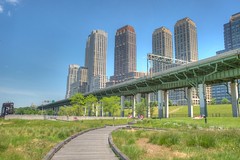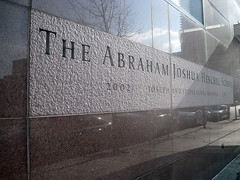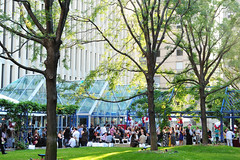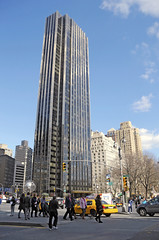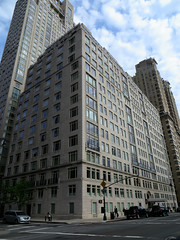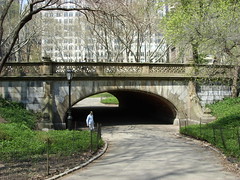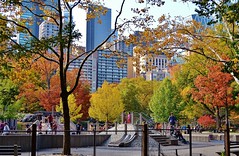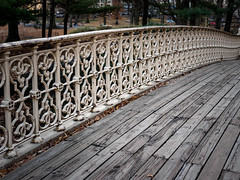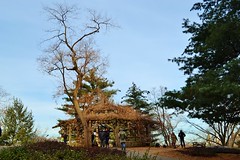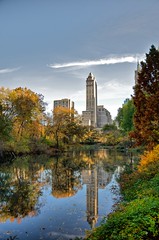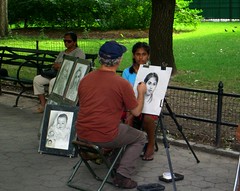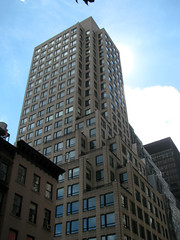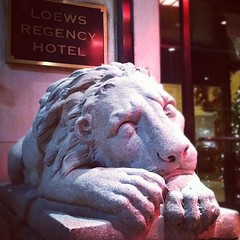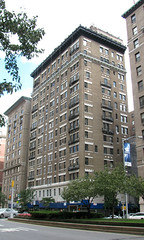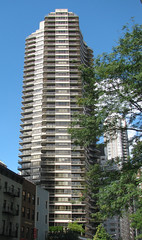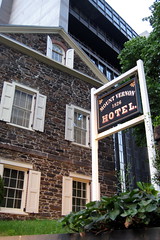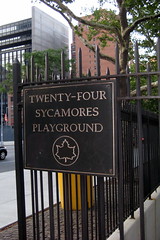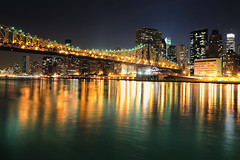South:
Hotel Pierre
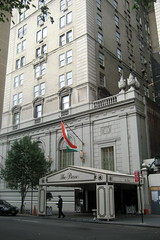
2 (corner): One of New York City's most
elegant hotels, built in 1929 by restaurateur Charles Pierre, (whose restaurant had just been replaced by the New York Central Building),
with the backing of E.F. Hutton, Walter Chrysler and others. Architects Schultze and Weaver based the 41-story tower's design in
part on the Royal Chapel at Versailles. Launched as the Great
Depression was beginning, the venture was bankrupt by
1932; the hotel was bought by J. Paul Getty in 1938 for $2.5 million, about one-sixth of what it cost to build.
The hotel's regular guests included Gary Cooper, Spencer Tracy, Aristotle Onassis, Jimmy Stewart, Audrey Hepburn, Tom Jones, Claire Trevor and Charles Bronson.
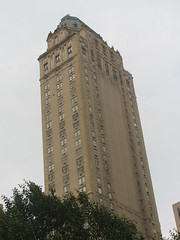
Woolworth's heiress Barbara Hutton had a suite, leading striking clerks to picket the hotel, chanting, "Is 18 dollars a week too much?"
John O'Hara wrote the first of his Pal Joey stories here in 1938;
Dashiell Hammett began writing The Thin Man here in 1932; he checked out without paying his bill, wearing all his clothes at once.
French director Rene Clair lived here after fleeing
the German invasion of France.
Lucille Ball and Desi Arnez had a six-week honeymoon here
in 1940. Barbara Stanwyck and Robert Taylor lived here
together before their 1950 divorce.
Composer Richard Rodgers spent the last years
of his life here, dying in bed on December 30, 1979.
On January 2, 1972, armed robbers (reportedly
associated with the Lucchese crime family) took over the hotel to rob its safety deposit boxes of as many as $10 million in jewels. Two of the crooks were soon caught; the rest got away with the bulk of the loot.
Al Pacino, Robert Redford, Lee Iacocca and George Steinbrenner were a few of the devoted customers of the hotel barber, Gio Hernandez,
who died in 1989.
Joe is told to stay here rather than at the Plaza in Joe vs. the Volcano. The dance scene in Scent of a Woman was shot in the Pierre's Cotillion Ballroom. On Mad Men, the relaunched Sterling Cooper
Draper Pryce ad agency temporily does business out of a suite here. The penthouse serves as the title character's apartment
in the 2011 remake of Arthur.
The Pierre was built on the site of Elbridge
Gerry's mansion, an 1897 French Renaissance structure designed
by Richard Morris Hunt. Gerry was a lawyer and philanthropist
whose grandfather was the namesake of the
Gerrymander.
Barney's
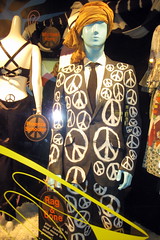
Corner (660 Madison): Founded in 1923 by Barney Pressman, this New York retail icon moved its flagship to the Upper East Side in 1993, where it occupies nine floors of the 22-story building. Noted for its sometimes bizarre Christmas windows; Lady Gaga was in charge of the holiday decorations in 2011. The store appears in the movie First Wives Club.
|  It was called the Muhhekunnetuk by the Mahicans, meaning the River
That Flows Both Ways—a reference to its formal status as an
estuary or fjord, a glacier-carved branch of the sea with salt water
as high as Newburgh and tides all the way up to Troy. Originally
known by the Dutch as the North River—as opposed to the South River,
now called the Delaware—its current name honors Henry Hudson,
the English explorer who sailed up it in 1609. He's also the namesake
of Hudson Bay, where mutinous crewmen left him to his presumed death in 1611.
It was called the Muhhekunnetuk by the Mahicans, meaning the River
That Flows Both Ways—a reference to its formal status as an
estuary or fjord, a glacier-carved branch of the sea with salt water
as high as Newburgh and tides all the way up to Troy. Originally
known by the Dutch as the North River—as opposed to the South River,
now called the Delaware—its current name honors Henry Hudson,
the English explorer who sailed up it in 1609. He's also the namesake
of Hudson Bay, where mutinous crewmen left him to his presumed death in 1611.
